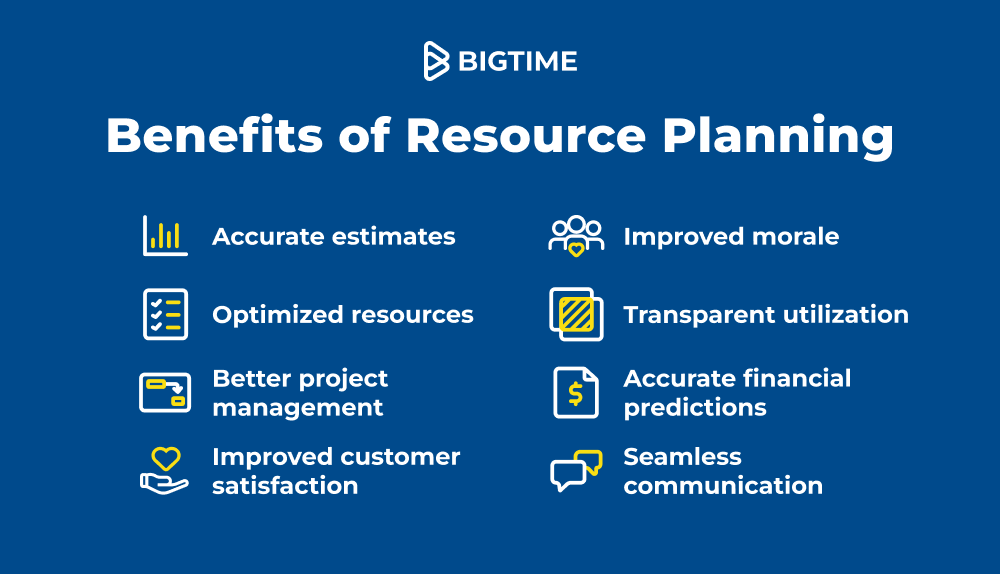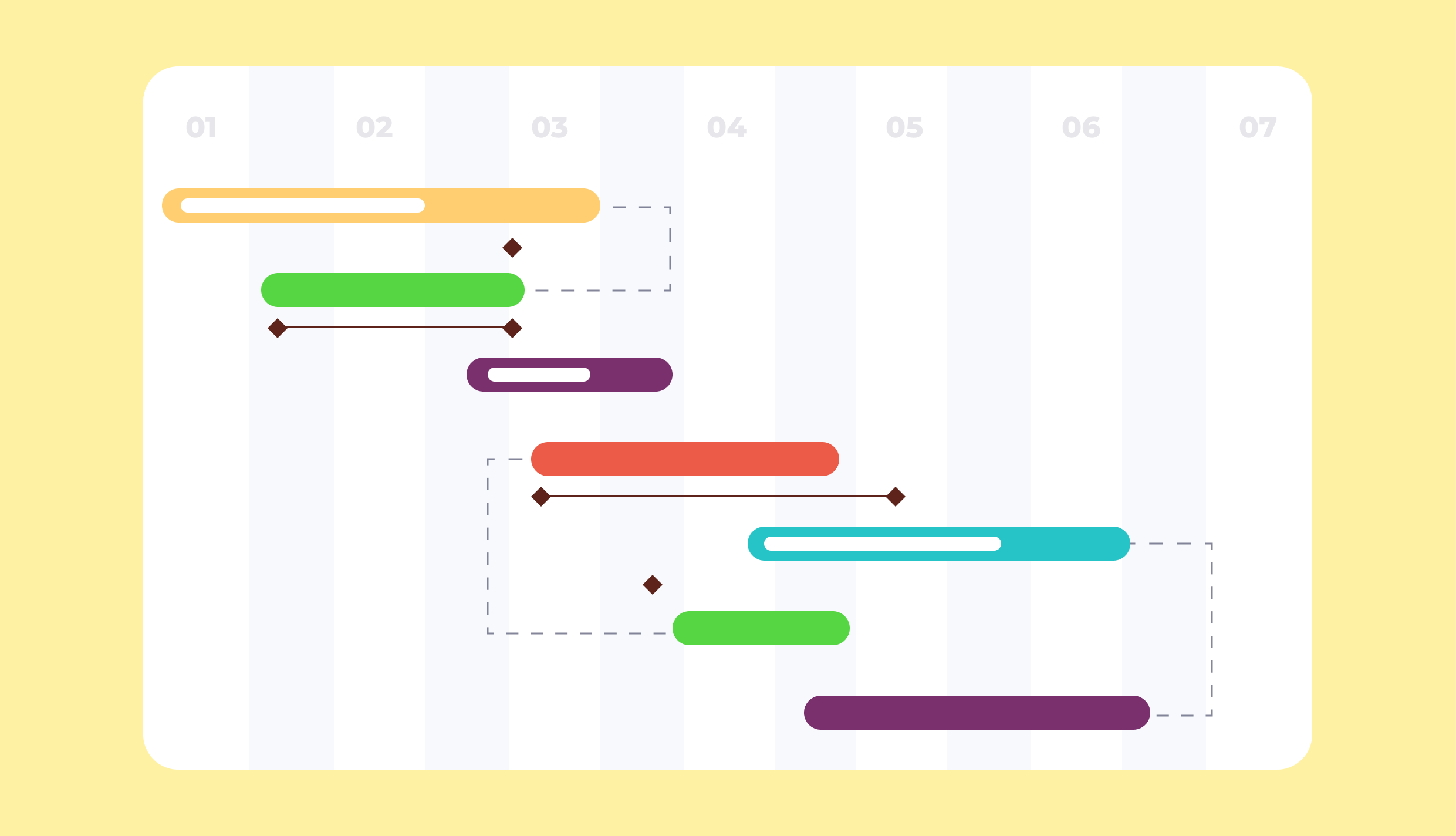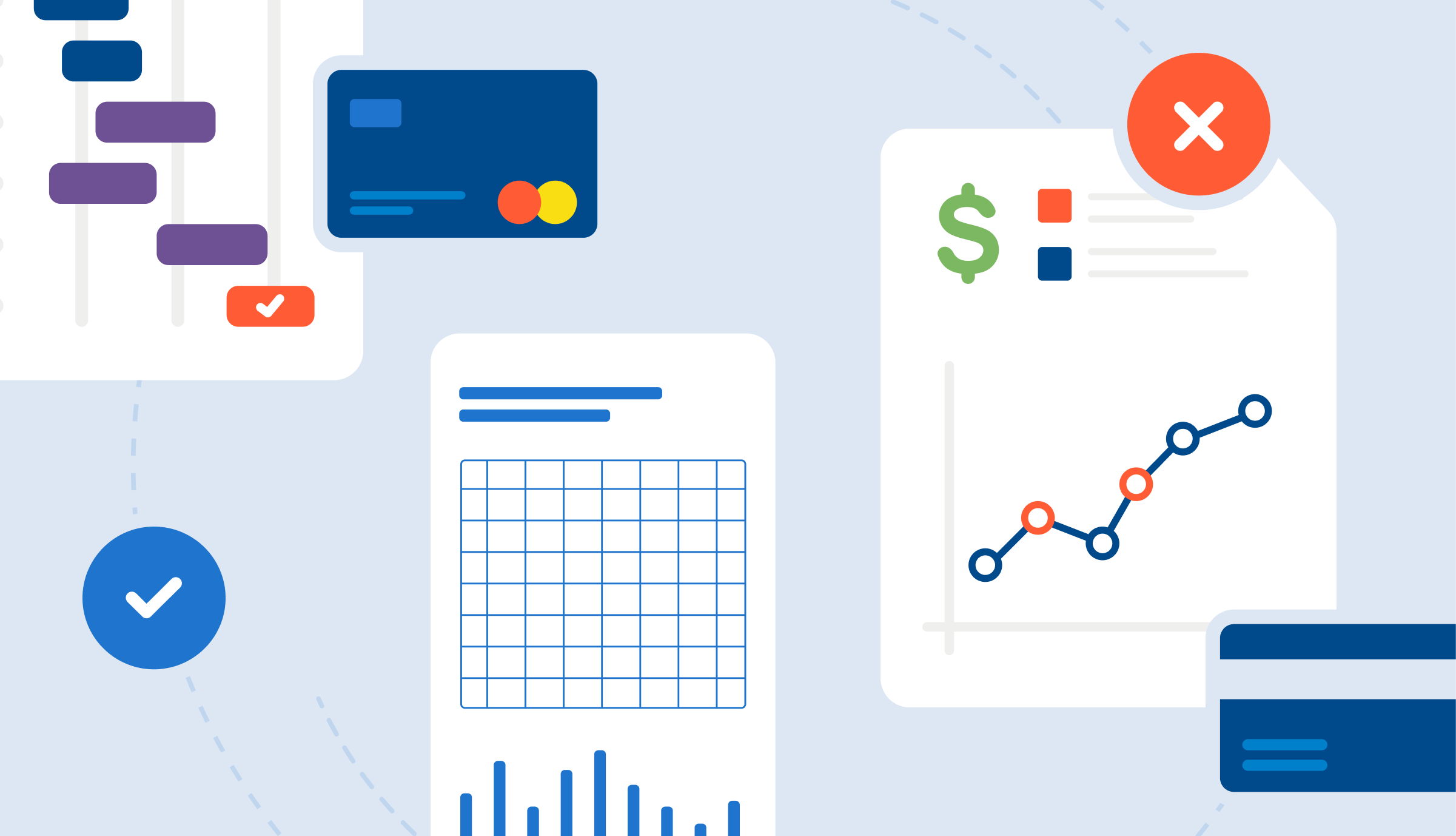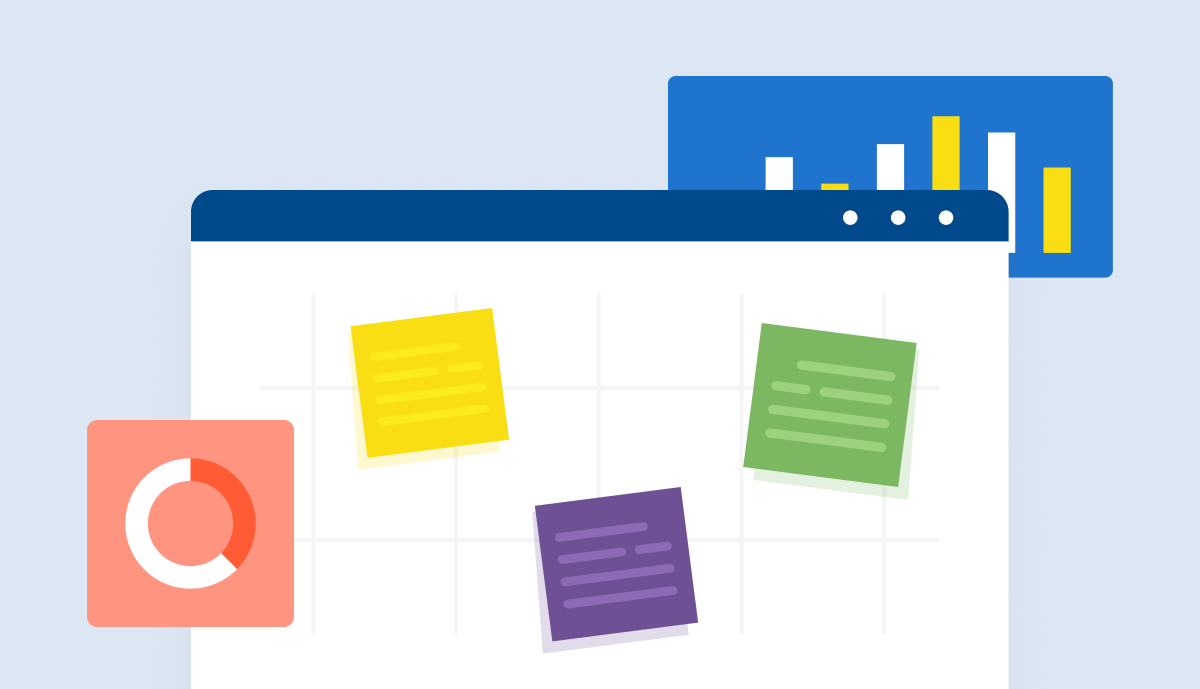The work of your employees is the source of your profits — but do you know how to manage their time efficiently and make the most out of it?
In this article, we will dive deeper into resource planning processes and show you all the tips and tricks you can use to improve resource management at your professional services organization.
What is a resource planning process?
In short, the resource planning process is a chain of actions that helps managers oversee their employees’ working hours.
Resource planning generally refers to the process of assigning and allocating specialists to projects or specific tasks based on their skills, experience, certifications, and other factors an employer finds valuable in a given case. In general, the process is the responsibility of project managers.
Generally speaking, the resource planning process can be applied to:
- Employees or team members
- Teams
- Contracts
- Projects
- Schedules
- Or any other resource you may need to complete a project
What is the point of having a resource planning process?
The main goal of resource planning processes is to improve the accuracy and reliability of plans and estimations and spot any inconsistencies in the project before they impact the results.
Consequently, they save both project managers’ and employees’ precious time and help companies thrive with more money in the bank.
What is the resource planning process?
The resource planning process is not the simplest one. In its current version, it consists of 6 stages. We’ll dive into each step later on in this article.
- Project planning
- Exchange of information
- Allocation of resources
- Time tracking
- Forecasting future planning
- Updating the plan
Just by looking at this list, you can see that these stages focus on multiple layers of business operations with a significant impact on resources. As such, they require a comprehensive approach to every sphere of business, including:
- Resource capacity
- Availability of resources
- Absences
- Skill management
- Time tracking
- Communication
- Project finances
- Overlapping schedules for various operations
Resource planning processes can be even more complicated in some industries.
For example, the professional services industry involves additional challenges in resource planning, such as dynamic wages, different types of contracts, and numerous billing methods.
As a result, the resource planning process should concern not only project managers but also people responsible for sales and finances.
What are the different types of resource planning processes?
In general, there are two types of resource planning processes.
Demand Planning
The first one is called the hypothetical resource planning process (also known as demand planning). In this type of planning, we establish what resources are needed for a project and allocate them freely without any constraints, such as absences or public holidays.
It gives project managers a general outline of the specialists needed to complete the project on a given schedule.
However, such a plan aims to determine an estimated demand for the services; it’s not suitable for precise planning. That’s why it has to be used in conjunction with another type of resource management, the actual resource planning process.
Actual Resource Planning Process
This type is mostly used to compare the demand established in the hypothetical plan with the real resource availability of the company.
At this point, the outline meets the actual data, resulting in a more realistic schedule for the entire project.

While the resource planning process may seem burdensome, it certainly has some advantages that outweigh the amount of work it involves.
That’s because such a plan can provide you with:
Accurate estimations and plans. According to PMI, 43% of projects are not completed within budget, and nearly half (48%) are not completed on time. A resource planning process can help with resource allocation, prevent your operations from failing, and show you risks you want to avoid — all to ensure the success of your endeavors.

Optimized use of resources. Are some of your specialists working overtime, while others are benched? No more — with resource planning processes in place, you can optimize your use of resources without over- or underworking anyone by managing resources evenly regardless of the circumstances. You can also check who’s working on which projects and when.
Accurate financial predictions. The project’s profitability should not be an enigma until the very end. By using resource planning processes combined with sufficient management tools, you can precisely estimate a project’s budget and see whether it is worth the effort.
Better project management. If you work in a service company, you surely have more than one project on your hands. Fortunately, they do not have to be tangled together — with resource planning processes and the right management tool, you can see exactly how and when they overlap, and you can react accordingly.
Improved client satisfaction. With accurate plans, you can inform a client about your exact schedule, and, above all, you can stick to it. Is there anything better for a client than a company that can deliver a project exactly as planned?
Seamless communication. Project portfolio management is often difficult — making the right decisions is even more difficult. Fortunately, with resource planning processes, you can quickly spot any problems and discuss them with other managers or interested parties.
Improved morale. No employee likes to be surprised with additional duties almost overnight. Fortunately, with resource planning processes, they can plan their work and be more productive.
Better planning for the future. Resource planning processes help organizations anticipate and allocate resources efficiently, ensuring optimal utilization and strategic alignment for effective planning and future success.
Improved human resource management. A resource planning process can be useful for more than just creating schedules. With a proper tool, you can use it to see the status of a given specialist (hired, onboarding, offboarding, former), see their work history, check their workload, and more.
Resource Planning Steps
1. Project Planning
If you started your project life cycle management with an in-depth analysis, project planning should be a piece of cake.
The key objectives of this phase include:
- Determining the main deliverables.
- Dividing a project into phases and determining the resources needed.
- Listing basic tasks with the skills required for their completion.
- Doing a hypothetical resource planning phase by determining the demand for particular skills in the project, as well as estimating the time particular specialists need to complete their tasks.
- Determining the profit margin, time, and budget for the project.
While this may seem burdensome by itself, it is just the beginning of the actual project resource planning process. Now, you have to put your project plan to the test.

2. Exchange of Information
To plan resources successfully, you need to know what options are available — and to do that, you need access to resource availability information.
The goal of the exchange of information is simple — to establish whether the company has the resources to complete the project, and how it can complete it.
The key objectives of this phase include:
- Verifying the information on the availability and capacity of necessary specialists,
- Creating a realistic resource plan based on the information above.
Many guides to the resource planning process claim that the only way to gather the information is to hold numerous meetings.
While we agree that is one of the ways to achieve this goal, we don’t believe it’s the most efficient way — from our perspective, sitting with several or more other people trying to come to the same conclusions is burdensome, to say the least.
However, in modern resource planning, meetings can often be replaced by information gathered automatically by resource management software, such as BigTime. In fact, they can provide every piece of data a meeting would (and more) including information on:
- Capacity
- Vacancies
- Planned absences
- Overtime
- Costs and wages
- Public holidays
At the same time, such tools do not require time-consuming preparations.
Importantly, they also don’t replace the meetings that are still essential for finding common ground among teams and managers. Instead, they provide the people in charge with the information they need to maximize the output of every meeting while keeping it as short as possible.
3. Allocation of Resources
Resource allocation of resources is all about matching available employees with the stages of the project they are best suited to participate in.
The key objectives of this phase include:
- Comparing the list of available resources with the project schedule.
- Assigning people to different stages of the project.
- Estimating the costs of work for the project and comparing them to expected profitability.
- Double checking the allocations for any absences or vacancies.
4. Time Tracking
Every employee tracks their working time daily — but is there something more to this part of the resource planning process?
The key objectives of this phase include
- Monitoring the progress of the project.
- Ensuring the project stays within the budget.
- Spotting any inconsistencies and delays one needs to react to.
Importantly, time tracking should not be treated as another formality standing in the way of an efficient project. It should be an important source of information on delays, overtime, or other issues that you need to address.
5. Forecasting Future Planning
The project may end, but the resource planning process never does. After a project ends, you should use the data you gathered throughout to create forecasts and improve the projects you may work on in the future.
The key objectives of this phase include:
- Predicting the demand for your services and products.
- Determining turnover rates and any employment problems you may have.
- Creating a list of the risks and mistakes you wish to avoid in the future (if any).
Why is my resource planning process failing?
Are things not going according to plan? No problem — just check whether any of these problems apply to your resource planning process and resolve them right away.
Lack of meetings with customers.
Occasionally, you simply cannot figure out where to go next on your own. Contact the customer to solve the most pressing issues. Hold meetings to establish priorities and resolve conflicts.
Lack of data analysis.
Compiling data and monitoring progress should be brought up regularly during meetings with customers. Only in such meetings can you identify the problem before it impacts your project.
Lack of a single source of knowledge.
Finances, availability, employee workload, employee skills, and more — these are all features that need to be taken into consideration during resource allocation. Ignoring them, or simply lacking access to them, may lead you to repeat mistakes in budgeting allocations.
Not considering time off and public holidays.
Time off and public holidays cut the number of working hours, and they may cause delays if not included in the final project plan. If you use the right tool, public holidays are always visible in advance.
Different understandings of key indicators.
Key indicators, such as utilization and capacity, can be interpreted differently by different people in the company. Make sure you discuss them in detail with every party involved, so everyone is on the same page.
Omitting projects from the sales funnel.
If you work in a service company, your sales team has some pending projects that will start soon. Make sure that they’re included in your plans.
Not taking into account internal projects.
Internal projects require time and effort from your employees, too. Ensure that you include these in your plans to avoid overtime.
Lack of soft bookings to better forecast occupancy.
Some projects may be tentative at the time you draft your plans for a given period, but that doesn’t mean you should simply omit them. Create soft bookings, so they don’t come as a surprise to your managers.






